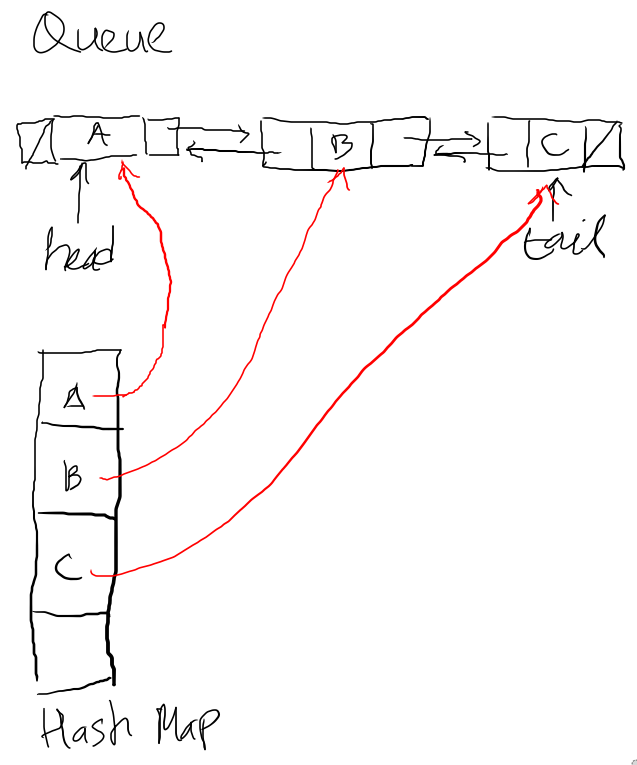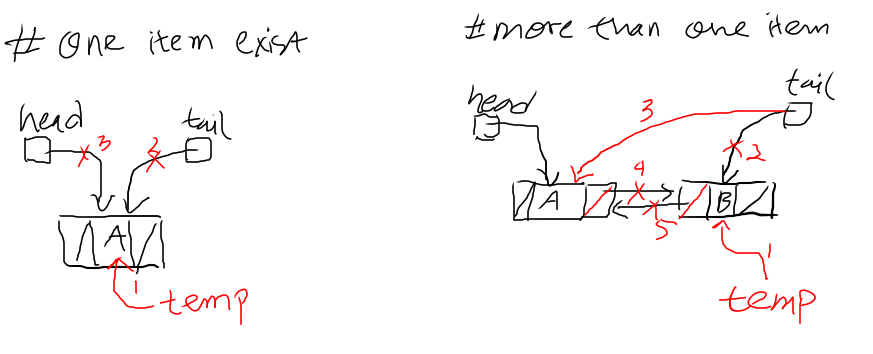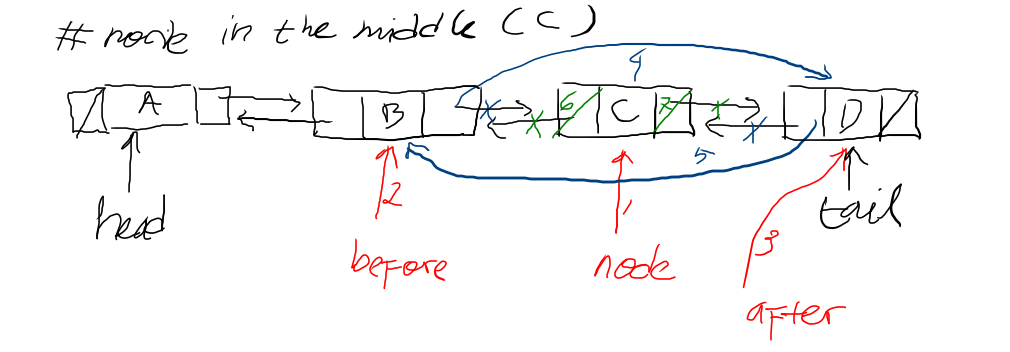What is LRU Cache And How It Works ?
What is LRU cache
A cache is a way to store data that accessed frequently and needs to be fast. We can use cache to store a result from computation or result of SQL query. A cache is usually stored in memory with a key-value style to make sure it fast to store item and access.
One of the cache algorithms is LRU or Least Recently Used. LRU will limit the memory usage by gives maximum items that can be stored. When there is a new item to be store and it already reached the limit, it discards the least used item.
How to make LRU Cache in GO
TLDR
Check the full code in this repo
There are two main components in LRU cache, those are Queue and Hash Map. The Queue is used to store the items that implemented in a linked list, while the Hash Map is used to make the complexity O(1) when accessed.

Creating Queue permalink
Disclaimer
The queue I implemented is based on my opinion, it may not be the “right” one :)
We need to create a struct for the cache item, a linked list node, and the queue.
type Queue struct {
head *Node
tail *Node
}
type Node struct {
item Item
next *Node
prev *Node
}
type Item struct {
Key string
// Value is used to store an item
Value interface{}
}We will create three methods for the queue InsertFirst, RemoveLast, and RemoveNode.
The structure of the Node. It has three parts, prev, value, and next. The prev and next are pointers to an adjacent node. The value is an interface{} that can hold any data type. 
These are algorithm and code for InsertFirst 
// insert a node into the first of the queue
func (q *Queue) InsertFirst(newHead *Node) {
if q.isEmpty() {
q.head = newHead
q.tail = newHead
return
}
oldHead := q.head
newHead.next = oldHead
oldHead.prev = newHead
q.head = newHead
}These are algorithm and code for RemoveLast 
// remove a node from the last queue
func (q *Queue) RemoveLast() *Node {
if q.isEmpty() {
return nil
}
if q.isOne() {
last := q.tail
q.tail = nil
q.head = nil
last.breakLinks()
return last
}
oldLast := q.tail
newLast := q.tail.prev
q.tail = newLast
oldLast.breakLinks()
return oldLast
}These are algorithm and code for RemoveNode 

// remove a node from any position in the queue
func (q *Queue) RemoveNode(node *Node) {
if q.isEmpty() {
return
}
if q.isOne() {
q.head.breakLinks()
q.tail.breakLinks()
node.breakLinks()
return
}
// node is first in the queue with following N-nodes
if node == q.head {
// new head is the next in the queue
q.head = node.next
node.breakLinks()
return
}
// node is the last in the queue with previos N-nodes
if node == q.tail {
// new tail is the one before the node
q.tail = node.prev
node.breakLinks()
return
}
// node is in the middle of the queue
after := node.next
before := node.prev
// link the before & after
before.next = after
after.prev = before
node.breakLinks()
}The code for MoveToFirst
func (q *Queue) MoveToFirst(node *Node) {
// no need to move, there is one or none in the queue
if q.isEmpty() || q.isOne() {
return
}
if q.head == node {
return
}
if q.tail == node {
beforeTail := node.prev
q.tail = beforeTail
beforeTail.next = nil
node.breakLinks()
node.next = q.head
q.head = node
return
}
nodeBefore := node.prev
nodeAfter := node.next
nodeBefore.next = nodeAfter
nodeAfter.prev = nodeBefore
node.breakLinks()
node.next = q.head
q.head = node
}Helper methods for the Queue
func (q *Queue) isEmpty() bool {
return q.head == nil && q.tail == nil
}
func (q *Queue) isOne() bool {
return q.head != nil && q.head.next == nil
}The breakLinks method is implemented as follows
// set next & prev to nil
func (n *Node) breakLinks() {
if n == nil {
return
}
n.next = nil
n.prev = nil
}Creating LRUCacher permalink
// LRUCacher not concurrent safe
type LRUCacher struct {
queue *Queue
hash map[string]*Node
MaxSize int
count int
}Codes for Put
// Put set new or replace existing item
func (l *LRUCacher) Put(key string, value interface{}) {
if l.MaxSize < 1 {
l.MaxSize = DefaultMaxSize
}
if l.queue == nil {
l.queue = NewQueue()
}
if l.hash == nil {
l.hash = make(map[string]*Node)
}
item := Item{
Key: key,
Value: value,
}
// if key already exist just replace the cache item
oldNode, ok := l.hash[key]
if ok {
oldNode.item = item
return
}
node := &Node{item: item}
if l.queueIsFull() {
last := l.queue.RemoveLast()
l.removeItem(last.item)
l.hash[key] = node
l.queue.InsertFirst(node)
return
}
l.hash[key] = node
l.queue.InsertFirst(node)
l.count++
}The recently called item, will be move to the first of the queue
func (l *LRUCacher) Get(key string) interface{} {
if l.hash == nil {
return nil
}
val, ok := l.hash[key]
if !ok {
return nil
}
l.queue.MoveToFirst(val)
return val.item.Value
}Codes for Del
func (l *LRUCacher) Del(key string) interface{} {
node, ok := l.hash[key]
if !ok {
return nil
}
l.queue.RemoveNode(node)
l.removeItem(node.item)
l.count--
return node.item.Value
}Notes on Implement Synchronization for Concurrency
The previous codes work for non-concurrent usage because when accessing & writing to the hash map or queue, there are needs for lock and synchronization. Also keep in mind, that adding synchronization will impact the performance.
We can use a mutex for synchronization. In Go, there are two types of mutex, Mutex and RWMutex. The Mutex is general purpose for locking only one goroutine that has access to a resource. The RWMutex has two locking mechanisms. The first is RLock that can behold by multiple gorutines and is used for reading. The Second is a Lock that can only behold by one goroutine and is used for writing.
I use two mutexes for LRUCacher, hashMutex for access & mutating hash, and countMutex when mutating the count. Also, to help to detects race condition, I use -race flag when running the go test
go test -race ./...
The rest of the code can be checked in this repo lrucache
type LRUCacher struct {
maxSize int64
queue *Queue
count int64
countMutex sync.RWMutex
hash map[string]*Node
hashMutex sync.RWMutex
}The benchmark
go test -benchmem -run=^$ -bench ^(BenchmarkLRUCacher)$ github.com/fahmifan/lrucache
goos: linux
goarch: amd64
pkg: github.com/fahmifan/lrucache
cpu: Intel(R) Core(TM) i5-7400 CPU @ 3.00GHz
BenchmarkLRUCacher/Put-4 2813918 422.4 ns/op 89 B/op 4 allocs/op
BenchmarkLRUCacher/Get-4 9076047 131.4 ns/op 16 B/op 1 allocs/op
BenchmarkLRUCacher/Del-4 11179544 107.6 ns/op 12 B/op 1 allocs/op
PASS
ok github.com/fahmifan/lrucache 4.228s
That’s the LRU Cache and how you can implement it in Go :)